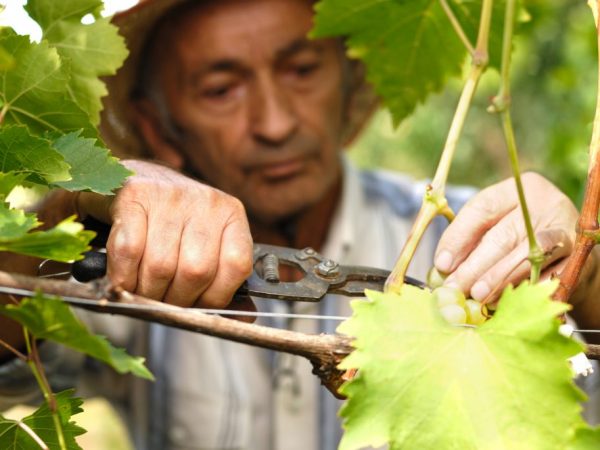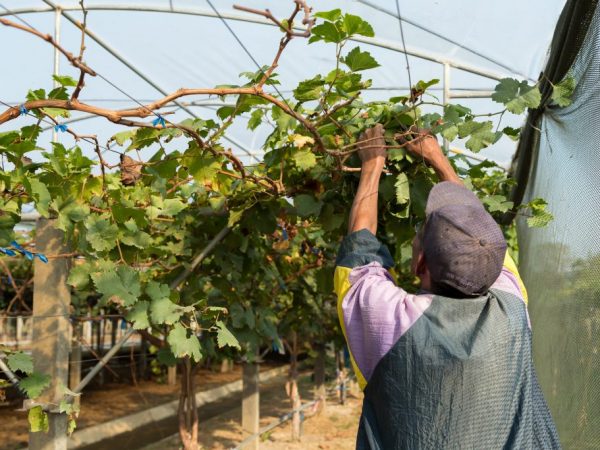Features of minting grapes
Some of the procedures used by gardeners in vine care have an ambiguous reputation among practitioners. These include the chasing of grapes. It is designed to improve the yield of the plant and protect it from standard problems. The expediency of the procedure is determined by the growing conditions of the grapes and by the gardener himself.

Features of minting grapes
Features of minting grapes
Summer chasing of grapes consists in the removal of the tops of the shoots of the vine. This procedure lends itself to stems grown on the main perennial trunk, on replacement branches and fruit arrows. Unlike pinching, this procedure lends itself to a longer branch, the removed part is much larger.
The benefits of minting grapes are as follows:
- the inflow of nutrients to the bunches and dormant buds is redistributed;
- improved airing of the bush and the illumination of the fruit by the sun;
- the vine is protected from fungal infections and putrefactive formations;
- young shoots ripen faster and are prepared for wintering.
Most often, grapes are minted with an average ripening period: it is able to accumulate an excessive amount of green mass. Leaves consume a lot of nutrients, slowing down the accumulation of sugars by berries, so their ripening is sometimes delayed until the onset of cold weather. Early grape varieties are rarely minted: they have time to give a full harvest faster.
Dates of the procedure
The minting of vines is started during the period of slowing down of the main growth of young shoots. A kind of signal for the beginning of the procedure is the straightening of the top of the vine. At the stage of active growth, the branches bend downward, since one side of the stem is stronger and develops faster. When the development of the ventral and dorsal sides is aligned, the shoot acquires the correct position.
For each variety, this manipulation has a specific deadline:
- for early varieties - late July-early August;
- for mid-ripening and late - mid-August.
Special timing of the minting in plants that are cultivated in greenhouses or greenhouses. Pruning of branches above 1 m of growth is carried out in July, if necessary. Subsequently, the branches are shortened at the end of August and in October to compact the tree trunk.
Stages of minting

The procedure promotes the early ripening of berries
Chasing of grapes in summer is done with pruners. During the process, the tops of the shoots are removed, which have 16-18 leaves along the entire length. The removed part should contain 4-6 leaves, their number depends on the total on the stem. The main condition is to leave at least 10-12 leaf blades above the upper bunch. Over the bunches of some vines, until they ripen, another 2-3 leaves are pinched off. This helps to improve the color of the berries and promotes their early ripening.
10-14 days after the procedure, the active growth of stepchildren begins.
They provide an accumulation of juices for the development of dormant buds, from which inflorescences will appear next year.If pruning is done too early, stepchildren grow too quickly and use the plant's reserve for the winter. Such growth processes can induce early dormant bud opening, which will weaken the vine and lead to a reduction in fruit ovaries in the next growing season.
In order to control the growth, the stepsons pinch as soon as 4-6 ripe leaves appear. Make sure that there are 2-3 leaves on each. In this amount, they help the grapes produce enough nutrients and keep dormant buds for the formation of ovaries in spring.
For some vigorous varieties, grape shoots are chased 3-4 times during the active growing season. The first one takes place before the beginning of flowering, when up to 13 leaves are left on each shoot. The following ones affect only stepchildren growing from a pair of upper buds to a height of 5-6 cm. The same actions are necessary when caring for irrigated plants: their growth rate exceeds the ability to accumulate nutrients. Shortening the branches of grape varieties with a fast growth rate will improve the ripening of berries and shoots by autumn.
After the procedure, all branches, leaves and buds are taken out of the site and burned. This prevents the development of diseases and the transfer of infections to healthy plants. If the vine was not infected, the resulting ash can be fertilized with other garden trees and shrubs, as well as the grapes themselves.
Contraindications for minting
Pruning does not always have a positive effect on the yield and well-being of the vine. There are some contraindications for this operation. Vine bushes are not minted when:
- grapes grow in regions with hot summers: a similar effect leads to superficial burns of leaves and delicate bunches;
- the berry variety belongs to wine, not table grapes - this grape is undersized and does not have excess green mass;
- a free vine grows along a gazebo, arch or veranda - it does not need to be chased, because it has stronger stems, is better illuminated by the sun, and brings a good harvest;
- a kind of pruning of young grapes will not give the expected results: its vines are not mature enough and have a small reserve of nutrients for the winter;
- the bush is weakened by disease or mechanical damage, it does not have enough strength to recover;
- there is a dry summer in combination with an attack of pests.
Conclusion
The process of embossing vine shoots is a useful but optional step in the vine care process. It is carried out mainly in the summer to help the plant cope with the ripening of fruits and as a preventive measure against diseases such as mildew and gray rot. This manipulation has its own characteristics, and therefore its need should proceed from the grape variety, weather conditions and the physical condition of the bush itself.

